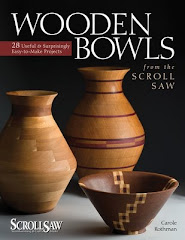I've been trying out some different designs lately, which require more precise cutting than I generally have to do. This has forced me to be aware of things that I had not considered seriously, such as where on the line you cut. The answer would seem to be simple--just cut on the line. However, unless you're using a pattern with very thin lines, most lines have two edges and a center, and where you cut does make a difference.
For example, if I'm cutting a piece that will be glued on its cut edge to another piece, I'll probably need to sand or joint the edge. In this case, I'll cut to the outside of the line, which lets me straighten out the edge and keep the required size. If, however, this is not the case and I'll probably be OK with the cut edge and no sanding, I cut carefully right down the middle of the line.
Or, if I'm cutting several pieces that need to fit together, I have to account for the wood lost to the kerf. Sometimes it doesn't matter, and the pieces will line up tightly without adjustment, but if there are center pieces, those may need to be cut on the outside of the line to prevent gaps. On the project pictured, the double ring box from the new box book, I used a very thin blade to keep the kerf small and I stack cut the pieces to create the bloodwood insert. Since the pieces were glued to a backing, any tiny spaces would not matter. The alternative would have been to inlay the bloodwood, but I wanted to keep this simple.






